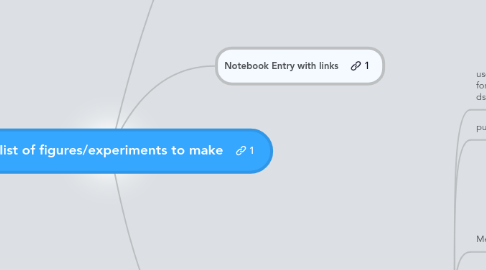
1. Notebook Entry with links
2. Richard's Suggestions
2.1. Sensitivity and Specificity
2.1.1. Wikipedia Article
2.1.2. Sensitivity - the ability of a test to determine positive results
2.1.2.1. 100% sensitivity has no false positives
2.1.3. Specificity - ability of a test to determine negative results
2.1.3.1. 100% specificity has no false negatives
2.1.4. So I guess in relation to SDM we need to evaluate the highest and lowest match scores
2.1.4.1. we may have done this for version 2
2.2. Richard suggests simulating unzipping for all fragments 1200 - 1700bp in length and testing for false positives, etc.
2.2.1. how feasible is this?
2.2.2. he asks, that conversely has our simulation results been made less sophisticated because we are restricting our library to just 2700 fragments instead of the 4^500 fragments otherwise
2.2.2.1. that number seems a bit excessive
2.2.2.2. Steve proposes generating something like 100,000 random sequences to insert into the library
2.2.2.2.1. maybe a mix of random sequences from different genomes: human, yeast, e. coli, other species of fungus, drosophila, etc and other plasmids
2.3. test simulated sequences against each other
2.3.1. may have been done, but no data
2.3.2. also do unzipped data vs unzipped data
2.3.2.1. post data to figshare?
2.3.3. add noise to simulated data incrementally to see how much difference the matching can handle
2.4. match uncontinuous DNA unzipping to simulation library
2.4.1. ie histone unzipping will create "gaps" in unzipping profile, so in one unzipping event you get regions of high force mixed with base-pairing unzipping
2.4.2. matching this to the library of simulations would be interesting
2.5. add nearest neighbor energy values to unzipping simulation
2.5.1. debatable whether it is worth adding it now
2.6. Link to public site with comments from Richard and responses by Steve
3. Improvements/Ideas after reading the paper
3.1. use simple hamiltonian but allow for ssDNA extension instead of dsDNA
3.1.1. paper says "Further we ignored elastic energy from the dsDNA anchoring fragment used in the unzipping experiments"
3.1.1.1. not sure what that means
3.2. put ALL software on github and link to it
3.3. Methods
3.3.1. Unzipping Data
3.3.1.1. put raw unzipping data on FigShare
3.3.1.2. put smoothed unzipping data on FigShare
3.3.2. Simulated Unzipping
3.3.2.1. link to specific yeast genome used (only states yeastgenome.org)
3.3.2.2. note any new methods that differ from original paper
3.3.3. Matching Algorith
3.3.3.1. input new match score system
3.4. Results
3.4.1. unzipping fragments are 2000bp in length regardless whether there is an xhoi site in the fragment. in "real" life this wouldn't be the case, so would it be worth it to simulate unzipping for all actual xhoi fragments and match short fragments to the library?
3.4.2. add noise to simulated unzipping data to get "experimental" unzipping data to match
3.4.2.1. how much noise?
3.4.2.2. how long does matching take?
3.4.3. increase window size for matching
3.4.3.1. this can probably be done if we add noise to simulated data
3.4.4. maybe we can quantify a successful match score: ie say anything that is below a 0.4 is a match
3.4.4.1. this could help identify false positives
3.4.4.2. could display robustness better as opposed to just comparing the correct matches to the rest.
3.5. Other stuff to include
3.5.1. SNP
3.5.2. Alternative splicing stuff
3.5.3. sequence mutations
